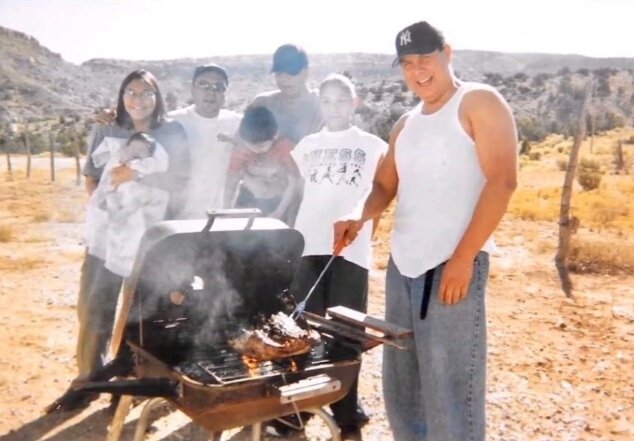
As Pulitzer Center grantee Nate Hegyi walked through the cramped hallways of a tribal jail on the Navajo Nation, he noticed a water leak and an unpleasant smell from the plumbing and stagnant water. The jails were falling apart.
Tribal jails are correctional systems maintained by individual tribes and sovereign nations as a part of their own public safety departments or departments of corrections. These jails are locally-run, short-term holding facilities. At least 19 men and women have died since 2016 in tribal detention centers overseen by the Interior Department's Bureau of Indian Affairs, including the Shiprock District Department of Corrections facility, according to an investigation by NPR and the Mountain West News Bureau.
“Federal officials have known about the mistreatment of inmates and other problems at the detention centers for nearly two decades. A 2004 federal investigation found widespread deaths, inmate abuse, attempted suicides, inhumane conditions and other issues in many of the more than 70 detention centers scattered throughout the U.S., including in Arizona, New Mexico, Montana, Wisconsin and Mississippi,” Hegyi writes in his article “Indian Affairs Promised To Reform Tribal Jails. We Found Death, Neglect And Disrepair.”
Through interviews with investigators, law enforcement, lawmakers, and victims' relatives—along with a review of documents including autopsy reports, jail logs, internal government reports, and lawsuits—Hegyi reported on inconsistencies in staff training, medical treatment, and building infrastructure.
Pulitzer Center intern Alexis McCowan spoke with Hegyi to learn more about the inspiration behind the push for reform in tribal jails and Hegyi’s approach to reporting. The following Q&A has been edited for clarity and length.
Alexis McCowan: What led to your interest in reporting on the conduct of tribal jails?
Nate Hegyi: I got a tip a year ago from a man who said that a friend of his had lost her son in one of these jails on the Blackfeet reservation as a 22-year-old man, grocery store worker named Willie, who died in the Blackfeet jail. That kind of sent me on a journey of digging into these tribal jails, which are overseen by the federal government and oftentimes either directly managed or co-managed by an agency called the Bureau of Indian Affairs. We uncovered at least 19 deaths since 2016. Many of them that we were able to kind of get details on showed a pattern of negligence and mismanagement and disrepair. That led to two people dying preventable deaths.
AM: Were you able to report on the ground?
NH: I traveled thousands of miles in my truck visiting the Navajo Nation, Blackfeet reservation, places in north-central Montana talking with families. I was able to see two in the Navajo Nation, which really shed a lot of light on the kind of conditions in some of these facilities.
AM: Were families eager or hesitant to tell their stories?
NH: I found that all the families were very eager. A lot of times, families didn't know very many details about their loved ones' death. When someone dies in these jails, they kind of fall into the world of federal bureaucracy, where if you die in a county jail, you can pretty much directly go to the sheriff's department or whoever's running that jail and find out details. But when someone dies in a jail on the reservation, it immediately becomes the jurisdiction of the federal government. So the FBI is involved. The Bureau of Indian Affairs is involved. Sometimes tribal officials, tribal law enforcement involved, county law enforcement. So there's all these different law enforcement agencies that are involved. Everything just jams up. If you want to know how my son died, you have to file a public records request with the Interior Department, which is going to take months to come back. It depends on which state you're in, and whether you can get an autopsy report. It's really tough to even know that you have to do this stuff. Most of the time people feel left in the dark about what happened. Every family that I spoke with really wanted to tell the story of their loved one and who they were before they passed away. They also really wanted to know details. We filed multiple public records requests to get these documents from these jails, which showed exactly how someone died and which federal policies were violated.
AM: Why do you think this issue has not been widely covered in the news?
NH: There isn't a lot of media coverage of Indigenous communities. We're dealing with folks who are entered in correctional facilities and America, oftentimes, in the hierarchy of people we care about, inmates are oftentimes very much at the bottom. Minority inmates, specifically Indigenous inmates are way at the bottom. So while the federal government has known about this problem for years it just doesn't get a lot of media attention, for those reasons. It is also hard to find out these details. If I hadn't had the Pulitzer Center grant that gave me six months to be able to focus entirely on this project, I would not have been able to create the story that we were able to create. It took a lot of time and not a lot of outlets have that time to invest in something like this.
AM: What steps do you think people can take to help this issue become more discussed or solved?
NH: It comes down to money. The only way Congress ever spends more money on things is if the public is pushing for that. So I think there is a great parallel with the missing and murdered Indigenous women's crisis and how that's really gained traction over the past few years in Congress because of grassroots activism, because families who are affected by that are talking to the press, are pushing their senators and their lawmakers to address the issue. I think that's what needs to happen here is that stories like this can't just be one-off. They have been for years, just like federal investigations, they're one-off promises of change, and change never happens. Right now, there's just been a lack of accountability. They have solutions that haven’t been put into place yet.
AM: What should readers take away from this story?
NH: This story isn't surprising, right? There's an expectation that the federal government is going to mistreat tribal members and there's a long history of a pattern of that and this fits right into that mold. I think they (readers) should take away the fact that unlike other federal correctional facilities, there are no requirements to have doctors or nurses on staff, at least a third of the people who enter these facilities are arrested for drug- or alcohol-related charges. They're potentially at risk of dying from withdrawal seizures or acute alcohol poisoning. If there were trained health care providers on-site to better recognize the signs of alcohol poisoning, I think a lot of these deaths could be prevented, but because there are no doctors or nurses on staff it leads to a lot of preventable deaths. It puts correctional officers in a really tough position because they have to make potentially life-or-death decisions without the required medical training. That would be my big takeaway from the story.








